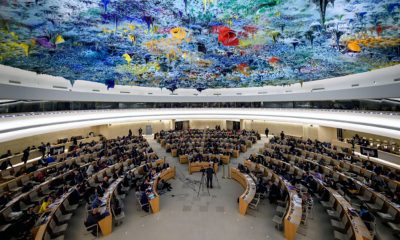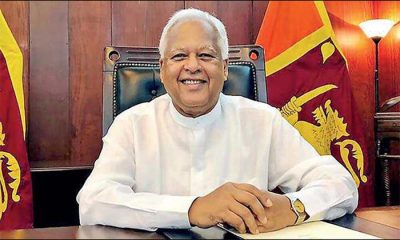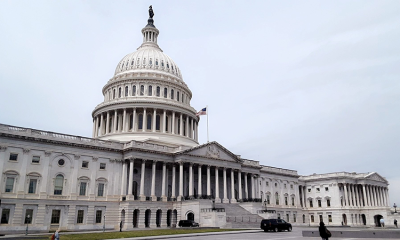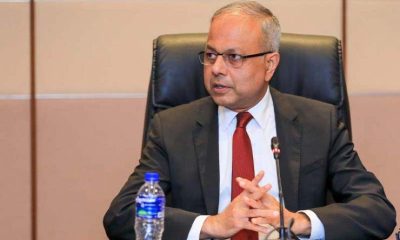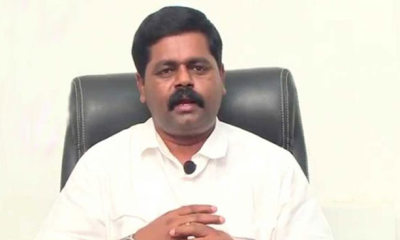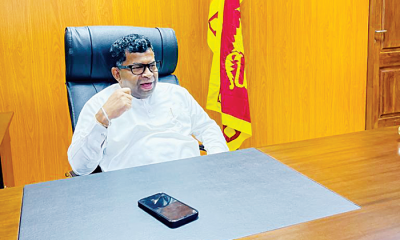Features
Effort to break logjam, Vijaya K, food drop and JR’s letter to Rajiv
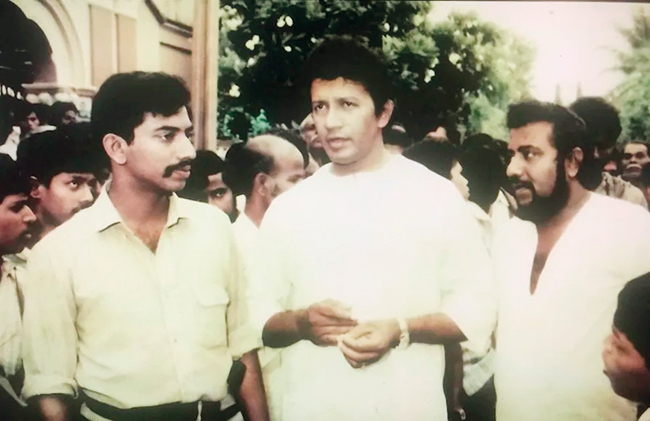
(Excerpted from volume ii of the Sarath Amunugama autobiography)
In fact it was Rajiv who made an attempt to break the logjam The Parathasarathy proposals had insisted on the joinder of the North and East. This was a ‘shadow’ of the TULF concept of their ‘traditional homelands’. No Sinhala leader could accept this ‘imaginary nation’ to use the celebrated phrase of Benedict Anderson and hope to survive not only politically but even as a living human being.
‘Kill the old man’ later became a JVP slogan inscribed on city walls. The Sinhalese and Muslims. and even sections of the Eastern Tamils who had been earlier ostracized by the Jaffna Tamils as low caste, were not willing to play second fiddle to the northerners. By now JRJ had accepted the notion of devolution and a second tier of Government by way of Provincial Councils which were originally proposed only for the North and East.
In Bangalore Rajiv shifted the Indian position by suggesting two Provincial Councils – North and East – which as two entities could evolve a system of cooperation at the ground level. Then came the fatal shock for Rajiv. He wanted Prabhakaran who up to then was looked upon as a client of the Indians -whom RAW insisted could be whipped into line – brought to Bangalore to agree to this new formulation which had the consent of the other Tamil groups.
Let us listen to Bernard Tillekeratne, our High Commissioner in Delhi at that time. “It was reported that Prabhakaran, who was then resident in Madras, had initially refused to proceed to Bangalore as desired by Gandhi, to meet Jayewardene and himself, should the need arise during their discussions. However, he was forced to be in attendance in Bangalore but reportedly refused to meet the Sri Lankan President.
At this point Gandhi decided to impose some restrictions on LTTE movement in Tamil Nadu and even sought to prevent Prabhakaran from leaving India, but he slipped across to Jaffna to continue his fight from there.”
This was a historic encounter which had fatal consequences. Some years later both Rajiv and Prabhakaran had premature and violent deaths as a consequence of the Bangalore impasse. Only JRJ died in bed after retirement at a ripe old age.
Intensified Conflict
JRJ flew back to Colombo after establishing cordiality with Rajiv to find that Prabhakaran’s LTTE was adamant in sabotaging a peace deal which had been agreed to by the other Tamil parties. As Bhandari told me, India had invested much hope in a consensus emerging from an all-party conference. JRJ’s invitation had been accepted by the LSSP, CP, NLSSP and Vijaya’s party. Tamil parties, save the LTTE, were also represented.
After the opening session the meeting broke up into different committees to discuss problematic issues. Gamini Dissanayake headed the committee on land matters, and I was asked to assist him. We were able to find unanimity in assigning land alienation undue village expansion to the relevant district as it was the prevailing practice even then. The knotty issue was the development of land under the major schemes in the Eastern Province.
The expansion of the Mahaweli settlement was being held back because of the impasse. We decided that sixty percent of the allotments should be on a ratio of the population in the district and forty percent on national quotas. Regarding the sharing of water on a cross border basis we recommended the setting up of a Riverine Commission, like in India, which would adjudicate on the distribution of water.
This found general acceptance and was indeed used for land alienation subsequently. Similarly other committees too made their recommendations. However the value of these efforts were undermined by the refusal of the party now dominated by Anura, to attend or endorse the findings of the all party conference.
Though the Tamil parties agreed to these suggestions their position on the ground in the North and East was deteriorating rapidly and Prabhakaran, who boasted that he had outwitted the Indians, was launching attacks particularly on unarmed Sinhala and Muslim civilians, which made JRJ’s position extremely unpopular among the Sinhala majority. He was under pressure from Lalith Athulathmudali who had reorganized the army under his watch, to take the fight to the LTTE, which in JRJ’s vulnerable position with the electorate, appeared to be a good move.
Accordingly the Lankan armed forces launched `Operation Liberation’ targeting Vadamaradchi. This was led by Cyril Ranatunga – a smart Sandhurst trained leader, together with Denzil Kobbekaduwa, who was my collegemate, and Wijaya Wimalaratne – three of the ablest fighting generals in our army which up to then had seen many setbacks due to poor leadership.
It was much later in Sarath Fonseka, who was then a subaltern, that we produced a military leader who could take his soldiers to victory. He was ably supported by the then Secretary of Defence, Gotabaya Rajapaksa who too had taken part in the Vadamaratchi operation. Much later in time I was a keynote speaker at the launch of a book by C.A. Chandraprema entitled `Gotas War’. I referred to the combination of persons and events which enabled the Government to successfully conclude the fratricidal war which had changed the trajectory of the country’s future.
Vijayas Call
At about this time I got a call from Vijaya Kumaratunga who played a vital role in the All-Party Conference. It was his bold leadership that helped in the positive outcome of the meeting. By this time he was recognized as the leader of the left and their obvious common candidate at the next Presidential poll. He was adored by his party loyalists as well as film fans who made him the most popular actor on our silver screen.
While many political leaders were ambivalent about devolution and a settlement with the Tamils, it was Vijaya who boldly spoke out on the need for a second tier administration – Provincial Councils – which were closer to the grass roots. Vijaya first told me that Denzil was leading a successful march to the heart of LTTE country in Vadamarachchi. He thought this offensive would change the tide and the All Party Conference conclusions were significant for the next steps in resolving the ethnic crisis.
Of all the leaders it was Vijaya and Chandrika who were winning the confidence of the non LTTE Tamils. Then he dropped a bombshell. He said that JRJ was going to make me the Minister of Information as Anandatissa de Alwis was ill and in hospital. He urged me to accept the offer and on no account have second thoughts. I told him that JRJ had made no such offer and anyway the younger Ministers would be unhappy to see an intruder complicating their well-planned ascent to power.
I heard later that this idea was shot down by them as I expected. But it was true that at that stage I was close to the President, and he would contact me regularly by telephone and also summon me to ‘Braemar’ to discuss the rapidly changing scenario. The only result of this little cameo was that Anandatissa who was very close to me became distant – the wonderful relationship we had could not be recreated due to his jealousy.
After retirement Ananda sent many messages to make up but I felt that I had been badly misunderstood and did not respond with the earlier warmth. One of my characteristics is that once a close friendship is broken it becomes for me to ‘forgive and forget’. On the other hand, this episode highlighted the natural generosity of Vijaya Kumaratunga that could reach out across barriers of politics at a personal level and encourage his friends without petty considerations of advantage
He had good relations with the non LTTE Tamil militants. the LTTE cadres had a regard for him and in typical bold ‘film’ style Vijaya undertook a visit to LTTE held Jaffna to free soldiers who were held hostage by Prabhakaran. His LTTE host was Kangaratnam, an old Trinitian, a fluent Sinhala speaker. Vijaya’s visit was facilitated by Colonel Kotelawela, a strapping six-footer of the army who was the official army liaison in Jaffna with Kanagaratnam who had assumed the ‘nom de guerre’ of Colonel Rahim.
No other Sinhala politician would dare to follow Vijaya’s bold venture. His political enemies circulated a video of Vijaya shooting at a target provided by the LTTE. But he not only returned unscathed but also retained his popularity though earning the hatred of the Sinhala ultras, particularly of the JVP. They marked him as their chief challenge and made plans to eliminate him from the political scene. Vijaya received many warnings from his friends but with typical bravado he chose to ignore them. He even challenged the JVP to harm him.
Nadir of Indo-Lanka Relations
Though JR and Rajiv had established a rapport in Bangalore despite Prabhakaran’s intransigence, the immediate aftermath led to a period when the two countries were on the verge of open conflict. There were four main reasons for the breakdown. The first was the reaction of the LTTE now led on the ground by Prabhakaran, which went on the rampage against unarmed Sinhalese villagers. In Vavuniya they stopped a passenger bus and slaughtered all 140 travelers. The pressure was building on JRJ to act decisively as the Sinhalese looked on him to give a fitting response.
He was conscious of the fact that he was fast losing popularity, which awakened his atavistic fear of losing everything as he did in 1956. The second was the success of ‘Operation Liberation’. The Sri Lankan army was on the verge of defeating the LTTE militarily when the Indian government represented by their ‘gung-ho’. High Commissioner Dixit forced JRJ to call off the offensive much to the anger of the military and Lalith Athulathmudali who gave leadership to the armed services. The Indian Government was giving in to the pressures exerted on it by the Tamil Nadu administration.
The third was the blockade on the North which was enforced on the orders of the President. He had been reading the memoirs of the Secretary of the British Cabinet during the world war, which referred to Churchill’s blockade of Northern Ireland to prevent its support to Hitler. The blockade and its images of starvation that was evoked by the Tamil Nadu administration of M.G. Ramachandran forced the hand of Rajiv whom advisors like Chidambaram believed was being manipulated by the ‘Old Fox’ from Sri Lanka.
Ramachandran unilaterally announced a donation of two million dollars to the LTTE, which brought relations between the two countries to near breaking point. JRj was also afraid of the reaction of the army which had borne the brunt of the fight with the LTTE. Cyril Ranatunga was a loyalist, but he too was under pressure to talk back to the President. As Esmond constantly reminded us, JRJ was afraid of a military coup.
Food Drop
We now come to the lowest Point in Indo-Lanka relations when India decided to unilaterally intervene through a physical violation of a neighboring country’s boundaries. It was an unprecedented violation of Sri Lankan sovereignty and a crossing of the Rubicon which has Permanently affected the relations between the two countries. At the personal level it was a bitter humiliation of a leader whom even his opponents regarded as the best defender of national interests by hook or by crook.
At first the Indians sent a flotilla of ships carrying food supplies. But on JRJ’s personal orders the navy was made ready to intercept them. The Indians then withdrew to base and got ready to airdrop the food supplies in spite of JRJ’s personal entreaty which is reproduced below. Indian Airforce transport planes carrying food cargoes were given an escort of fighter jets. It was touch and go but since we were badly outnumbered the President ordered non retaliation and the food was air dropped unhindered and the planes flew back without a mishap.
It is burnished in the Sinhala psyche as the ‘parippu drop’ on Sri Lankan soil, the first infringement of our airspace after the bombing of Colombo and Trincomalee by the Japanese during the Second World War. This was a sad moment in JRJ’s presidency. The sense of anguish is seen in the draft of a letter to Rajiv that JRJ himself penned and is now in my possession. A photograph of the draft, mostly in JRJs own handwriting, is included in this book. My recollection is that this final version was sent to Rajiv Gandhi. An offer to send Hameed as a personal envoy of the President was turned down by the Indians.
Letter to Rajiv Gandhi
I am reproducing JRJ’s letter to Rajiv Gandhi here not only because it is a historic document but also since it shows the sense of despair and frustration of a man who had always looked to India for inspiration when all his contemporaries either turned to the West or the Soviet Union. There is a legend that when the LSSP leaders in the forties sought to gather him to their fold (As a young lawyer he appeared for Bracegirdle of the LSSP in their challenge to the Colonial Governor’s order of deportation) he responded that he could not join them as he was ‘a follower of the Buddha and a lover of India’. Now he was forced to eat humble pie by a grandson of Nehru whom he had admired throughout his life. He wrote as follows:
“The Cabinet of Ministers has studied very carefully the representations made to his Excellency the President by his Excellency the Prime Minister of India, Shri Rajiv Gandhi. It is apparent that the Prime Minister is both incorrectly informed and wrongly advised.
“Firstly the attempts made over a period of 10 years by the President and his Government to find a political solution to the so called ethnic problem in Sri Lanka are well known to the Government of India, for they too have taken part in discussions since 1983. These steps have been outlined in detail in the President’s addresses to Parliament in 1984,1985 and 1986 and will be summarized again in his address of February 19th with complete documentation. There is nothing more any Sri Lankan Government can offer, now or in the future, without violating the independence, integrity and unity of Sri Lanka’s constitution.
“The Indian Government has stated publicly to the Tamil groups that it does not support the joinder of the northern and eastern provinces, the concept of a Tamil homeland and the creation of a separate state. It is these three issues that supposedly keep these groups from accepting the proposals.
“During these 10 years, except the TULF, the other groups have unleashed a violent, terrorist campaign in which more than 4,000 security personnel, civilians, men, women and children of all races have been killed, many more injured, rendered homeless and suffered immeasurable losses. The latest atrocity has been the killing of several Sinhala women and children, without provocation in the darkness of the night by the cutting of their throats.
As far as we know no terrorist group in the world has been guilty of such inhumane behavior. India has experience of terrorism in several states and particularly in the Punjab where a separatist movement is using violence to achieve its goal.
“The Sri Lanka Government, both politically and militarily has done nothing more nor less than the Indian Government has done and is doing in the Punjab to arrive at a solution. A speech in India made by Prime Minister Gandhi is available. If the proper names are used to indicate Sri Lanka and what is happening here, the speech will apply to Sri Lanka in its entirety.
“And what has the state of Tamil Nadu been doing during these .ten years? It has given refuge to Tamil groups, including those using violence. The leader of the LTTE group Prabhakaran who publicly says he murdered the Tamil Mayor of Jaffna, Mr. Duraiappah, and many others is entertained as a guest by the Chief Minister. He as well as others who direct violence in Sri Lanka, against a lawfully elected democratic government and self-governing local institutions are permitted to buy, possess arms and wireless sets, and train in military exercises. They are permitted to some over to Sri Lanka with men and military material to wage war on an independent, democratic Government.
“Though promises have been made that all this will be stopped these promises have not been fulfilled. Because of open warfare between nine groups a large quantity of arms and equipment was confiscated. The wireless sets that were confiscated were returned.
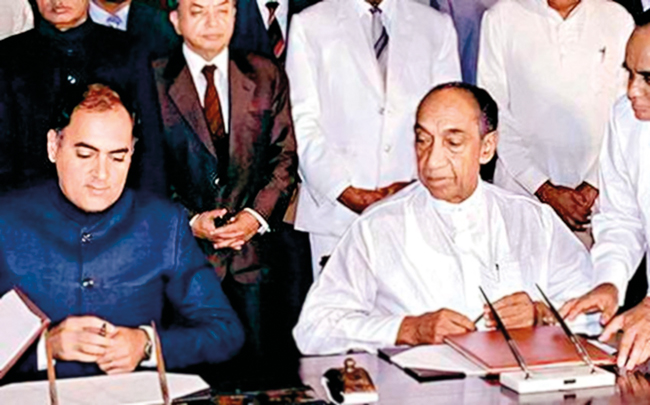
President JR Jayewardene and Indian Premier Rajiv Gandhi signing the historical Indo-Lanka Accord in 1987. The 13th Amendment to the Constitution facilitated by India through Indo-Lanka Treaty
:They are used to direct the war in Sri Lanka. The Central government of India is aware of these facts. The Government Sri Lanka will not cease its activities to defend democratic institutions and to restore law and order to free its citizens from attacks of a bunch of terrorists, just as much as it will not cease its attempts to arrive at a political solution. While following this two-pronged policy it is entitled to use its powers to persuade its opponents that their efforts cannot succeed but will only cause hardships to inhabitants living in the areas they control, namely the Jaffna Peninsula.
“During the Indian movement for freedom Mahatma Gandhi initiated a boycott of the use of foreign cloth. This hurt the workers in the Lancashire mills in England causing unemployment and severe hardships to hundreds of thousands. During a visit to England in 1931 for the Round Table Conference Mahatma Gandhi visited the Lancashire Mills and saw the hardships caused by his boycott. His reply was ‘Lord Irwin suggested that I give up the boycott for three months as a gesture. I said I could not give it up for three minutes’. [See Gandhi; ‘Essential Writings’, p 309].
“During the 1939 War the United Kingdom enforced a boycott on goods going to and coming from the Ports of Ireland because that Government was sympathetic to the Nazi Government. What we are doing is a legitimate method of non–violent tactics against a deadly foe, and instead of abandoning it, we should intensify it, rather than use more and more violence.
“Summing up we should state that our Government is committed to non-violence. If the terrorist groups give up violence and lay down their arms, the Government will immediately direct the security services to stay in their barracks. We will then implement the Provincial Councils scheme and hold elections so that together with the other seven provinces the people of the northern and eastern provinces may elect their councils, members, Chief Ministers and govern themselves in all the subjects and functions devolved on those councils as discussed and decided with the TULF and the Indian Government. The Tamil groups can take part in these elections for they will be pardoned under an amnesty if they abandon violence.
“All we ask of the Indian Government is, not to permit the soil of India to be used for violent activity against a friendly neighbor and not to permit such activities to be brought to Sri Lanka in the form of men and arms. This Government’s sole aim is to permit democracy and the rule of law flourish once again in the northern and eastern provinces, as in other provinces, under the administration of the elected representatives of the people living in them.
“May the Government of India help us to achieve this goal and may they persuade the Government of Tamil Nadu to do the same for the immortal heritage of India is that “We must not appease evil ….we must remember that evil is not surmounted by using methods that themselves produce more evil….means should not be subordinated to ends”.
“These quotations are from K. Natwar Singh’s book ‘The legacy of Nehru’. All we ask is be true to your heritage, fulfill the legacy of Nehru, refuse to compromise with violence, support the Government of Sri Lanka in its call to terrorists to lay down their arms and discuss your aims and solutions peacefully as we are always prepared to do”.
The Aftermath
The clear violation of Sri Lankan sovereignty came as shock to JRJ and the Government. The anguish is clear in JRJ’s heartfelt letter quoted above. But what was even more disconcerting was the silence of our friends on whom the President had banked heavily to restrain India. While Pakistan made some noises it was counterproductive in that it led to India being more intransigent. But what was disappointing to JRJ was the silence of the western countries which had been wooed assiduously by him.
He was particularly disappointed by the US reaction which relied on backroom warnings to India and not much else. There was no public condemnation by the West, SAARC or the ASEAN. To make the humiliation complete they advocated the hiring of mercenaries to supplement the local armed forces. They were willing to recommend private trainers but were reluctant to `Put boots on the ground’ which would have meant a clash with the Indian armed forces who were strenghtened with Indian weaponry under Rajiv.
Only Fidel Castro, as head of the Non-Aligned Movement, offered to call Rajiv urging caution. It was in this background when the only o[tion seemed to move to serious negotiation which our erstwhile western friends also recommended. With this shift JRJ began to turn to Gamini Dissanayake as his aide, while Lalith, angry that his ‘Operation Liberation’ had been aborted was consigned to the sidelines where he adopted a hawkish approach to India with many tragic consequences as we shall see later.
Features
The heart-friendly health minister

by Dr Gotabhya Ranasinghe
Senior Consultant Cardiologist
National Hospital Sri Lanka
When we sought a meeting with Hon Dr. Ramesh Pathirana, Minister of Health, he graciously cleared his busy schedule to accommodate us. Renowned for his attentive listening and deep understanding, Minister Pathirana is dedicated to advancing the health sector. His openness and transparency exemplify the qualities of an exemplary politician and minister.
Dr. Palitha Mahipala, the current Health Secretary, demonstrates both commendable enthusiasm and unwavering support. This combination of attributes makes him a highly compatible colleague for the esteemed Minister of Health.
Our discussion centered on a project that has been in the works for the past 30 years, one that no other minister had managed to advance.
Minister Pathirana, however, recognized the project’s significance and its potential to revolutionize care for heart patients.
The project involves the construction of a state-of-the-art facility at the premises of the National Hospital Colombo. The project’s location within the premises of the National Hospital underscores its importance and relevance to the healthcare infrastructure of the nation.
This facility will include a cardiology building and a tertiary care center, equipped with the latest technology to handle and treat all types of heart-related conditions and surgeries.
Securing funding was a major milestone for this initiative. Minister Pathirana successfully obtained approval for a $40 billion loan from the Asian Development Bank. With the funding in place, the foundation stone is scheduled to be laid in September this year, and construction will begin in January 2025.
This project guarantees a consistent and uninterrupted supply of stents and related medications for heart patients. As a result, patients will have timely access to essential medical supplies during their treatment and recovery. By securing these critical resources, the project aims to enhance patient outcomes, minimize treatment delays, and maintain the highest standards of cardiac care.
Upon its fruition, this monumental building will serve as a beacon of hope and healing, symbolizing the unwavering dedication to improving patient outcomes and fostering a healthier society.We anticipate a future marked by significant progress and positive outcomes in Sri Lanka’s cardiovascular treatment landscape within the foreseeable timeframe.
Features
A LOVING TRIBUTE TO JESUIT FR. ALOYSIUS PIERIS ON HIS 90th BIRTHDAY

by Fr. Emmanuel Fernando, OMI
Jesuit Fr. Aloysius Pieris (affectionately called Fr. Aloy) celebrated his 90th birthday on April 9, 2024 and I, as the editor of our Oblate Journal, THE MISSIONARY OBLATE had gone to press by that time. Immediately I decided to publish an article, appreciating the untiring selfless services he continues to offer for inter-Faith dialogue, the renewal of the Catholic Church, his concern for the poor and the suffering Sri Lankan masses and to me, the present writer.
It was in 1988, when I was appointed Director of the Oblate Scholastics at Ampitiya by the then Oblate Provincial Fr. Anselm Silva, that I came to know Fr. Aloy more closely. Knowing well his expertise in matters spiritual, theological, Indological and pastoral, and with the collaborative spirit of my companion-formators, our Oblate Scholastics were sent to Tulana, the Research and Encounter Centre, Kelaniya, of which he is the Founder-Director, for ‘exposure-programmes’ on matters spiritual, biblical, theological and pastoral. Some of these dimensions according to my view and that of my companion-formators, were not available at the National Seminary, Ampitiya.
Ever since that time, our Oblate formators/ accompaniers at the Oblate Scholasticate, Ampitiya , have continued to send our Oblate Scholastics to Tulana Centre for deepening their insights and convictions regarding matters needed to serve the people in today’s context. Fr. Aloy also had tried very enthusiastically with the Oblate team headed by Frs. Oswald Firth and Clement Waidyasekara to begin a Theologate, directed by the Religious Congregations in Sri Lanka, for the contextual formation/ accompaniment of their members. It should very well be a desired goal of the Leaders / Provincials of the Religious Congregations.
Besides being a formator/accompanier at the Oblate Scholasticate, I was entrusted also with the task of editing and publishing our Oblate journal, ‘The Missionary Oblate’. To maintain the quality of the journal I continue to depend on Fr. Aloy for his thought-provoking and stimulating articles on Biblical Spirituality, Biblical Theology and Ecclesiology. I am very grateful to him for his generous assistance. Of late, his writings on renewal of the Church, initiated by Pope St. John XX111 and continued by Pope Francis through the Synodal path, published in our Oblate journal, enable our readers to focus their attention also on the needed renewal in the Catholic Church in Sri Lanka. Fr. Aloy appreciated very much the Synodal path adopted by the Jesuit Pope Francis for the renewal of the Church, rooted very much on prayerful discernment. In my Religious and presbyteral life, Fr.Aloy continues to be my spiritual animator / guide and ongoing formator / acccompanier.
Fr. Aloysius Pieris, BA Hons (Lond), LPh (SHC, India), STL (PFT, Naples), PhD (SLU/VC), ThD (Tilburg), D.Ltt (KU), has been one of the eminent Asian theologians well recognized internationally and one who has lectured and held visiting chairs in many universities both in the West and in the East. Many members of Religious Congregations from Asian countries have benefited from his lectures and guidance in the East Asian Pastoral Institute (EAPI) in Manila, Philippines. He had been a Theologian consulted by the Federation of Asian Bishops’ Conferences for many years. During his professorship at the Gregorian University in Rome, he was called to be a member of a special group of advisers on other religions consulted by Pope Paul VI.
Fr. Aloy is the author of more than 30 books and well over 500 Research Papers. Some of his books and articles have been translated and published in several countries. Among those books, one can find the following: 1) The Genesis of an Asian Theology of Liberation (An Autobiographical Excursus on the Art of Theologising in Asia, 2) An Asian Theology of Liberation, 3) Providential Timeliness of Vatican 11 (a long-overdue halt to a scandalous millennium, 4) Give Vatican 11 a chance, 5) Leadership in the Church, 6) Relishing our faith in working for justice (Themes for study and discussion), 7) A Message meant mainly, not exclusively for Jesuits (Background information necessary for helping Francis renew the Church), 8) Lent in Lanka (Reflections and Resolutions, 9) Love meets wisdom (A Christian Experience of Buddhism, 10) Fire and Water 11) God’s Reign for God’s poor, 12) Our Unhiddden Agenda (How we Jesuits work, pray and form our men). He is also the Editor of two journals, Vagdevi, Journal of Religious Reflection and Dialogue, New Series.
Fr. Aloy has a BA in Pali and Sanskrit from the University of London and a Ph.D in Buddhist Philosophy from the University of Sri Lankan, Vidyodaya Campus. On Nov. 23, 2019, he was awarded the prestigious honorary Doctorate of Literature (D.Litt) by the Chancellor of the University of Kelaniya, the Most Venerable Welamitiyawe Dharmakirthi Sri Kusala Dhamma Thera.
Fr. Aloy continues to be a promoter of Gospel values and virtues. Justice as a constitutive dimension of love and social concern for the downtrodden masses are very much noted in his life and work. He had very much appreciated the commitment of the late Fr. Joseph (Joe) Fernando, the National Director of the Social and Economic Centre (SEDEC) for the poor.
In Sri Lanka, a few religious Congregations – the Good Shepherd Sisters, the Christian Brothers, the Marist Brothers and the Oblates – have invited him to animate their members especially during their Provincial Congresses, Chapters and International Conferences. The mainline Christian Churches also have sought his advice and followed his seminars. I, for one, regret very much, that the Sri Lankan authorities of the Catholic Church –today’s Hierarchy—- have not sought Fr.
Aloy’s expertise for the renewal of the Catholic Church in Sri Lanka and thus have not benefited from the immense store of wisdom and insight that he can offer to our local Church while the Sri Lankan bishops who governed the Catholic church in the immediate aftermath of the Second Vatican Council (Edmund Fernando OMI, Anthony de Saram, Leo Nanayakkara OSB, Frank Marcus Fernando, Paul Perera,) visited him and consulted him on many matters. Among the Tamil Bishops, Bishop Rayappu Joseph was keeping close contact with him and Bishop J. Deogupillai hosted him and his team visiting him after the horrible Black July massacre of Tamils.
Features
A fairy tale, success or debacle

Sri Lanka-Singapore Free Trade Agreement
By Gomi Senadhira
senadhiragomi@gmail.com
“You might tell fairy tales, but the progress of a country cannot be achieved through such narratives. A country cannot be developed by making false promises. The country moved backward because of the electoral promises made by political parties throughout time. We have witnessed that the ultimate result of this is the country becoming bankrupt. Unfortunately, many segments of the population have not come to realize this yet.” – President Ranil Wickremesinghe, 2024 Budget speech
Any Sri Lankan would agree with the above words of President Wickremesinghe on the false promises our politicians and officials make and the fairy tales they narrate which bankrupted this country. So, to understand this, let’s look at one such fairy tale with lots of false promises; Ranil Wickremesinghe’s greatest achievement in the area of international trade and investment promotion during the Yahapalana period, Sri Lanka-Singapore Free Trade Agreement (SLSFTA).
It is appropriate and timely to do it now as Finance Minister Wickremesinghe has just presented to parliament a bill on the National Policy on Economic Transformation which includes the establishment of an Office for International Trade and the Sri Lanka Institute of Economics and International Trade.
Was SLSFTA a “Cleverly negotiated Free Trade Agreement” as stated by the (former) Minister of Development Strategies and International Trade Malik Samarawickrama during the Parliamentary Debate on the SLSFTA in July 2018, or a colossal blunder covered up with lies, false promises, and fairy tales? After SLSFTA was signed there were a number of fairy tales published on this agreement by the Ministry of Development Strategies and International, Institute of Policy Studies, and others.
However, for this article, I would like to limit my comments to the speech by Minister Samarawickrama during the Parliamentary Debate, and the two most important areas in the agreement which were covered up with lies, fairy tales, and false promises, namely: revenue loss for Sri Lanka and Investment from Singapore. On the other important area, “Waste products dumping” I do not want to comment here as I have written extensively on the issue.
1. The revenue loss
During the Parliamentary Debate in July 2018, Minister Samarawickrama stated “…. let me reiterate that this FTA with Singapore has been very cleverly negotiated by us…. The liberalisation programme under this FTA has been carefully designed to have the least impact on domestic industry and revenue collection. We have included all revenue sensitive items in the negative list of items which will not be subject to removal of tariff. Therefore, 97.8% revenue from Customs duty is protected. Our tariff liberalisation will take place over a period of 12-15 years! In fact, the revenue earned through tariffs on goods imported from Singapore last year was Rs. 35 billion.
The revenue loss for over the next 15 years due to the FTA is only Rs. 733 million– which when annualised, on average, is just Rs. 51 million. That is just 0.14% per year! So anyone who claims the Singapore FTA causes revenue loss to the Government cannot do basic arithmetic! Mr. Speaker, in conclusion, I call on my fellow members of this House – don’t mislead the public with baseless criticism that is not grounded in facts. Don’t look at petty politics and use these issues for your own political survival.”
I was surprised to read the minister’s speech because an article published in January 2018 in “The Straits Times“, based on information released by the Singaporean Negotiators stated, “…. With the FTA, tariff savings for Singapore exports are estimated to hit $10 million annually“.
As the annual tariff savings (that is the revenue loss for Sri Lanka) calculated by the Singaporean Negotiators, Singaporean $ 10 million (Sri Lankan rupees 1,200 million in 2018) was way above the rupees’ 733 million revenue loss for 15 years estimated by the Sri Lankan negotiators, it was clear to any observer that one of the parties to the agreement had not done the basic arithmetic!
Six years later, according to a report published by “The Morning” newspaper, speaking at the Committee on Public Finance (COPF) on 7th May 2024, Mr Samarawickrama’s chief trade negotiator K.J. Weerasinghehad had admitted “…. that forecasted revenue loss for the Government of Sri Lanka through the Singapore FTA is Rs. 450 million in 2023 and Rs. 1.3 billion in 2024.”
If these numbers are correct, as tariff liberalisation under the SLSFTA has just started, we will pass Rs 2 billion very soon. Then, the question is how Sri Lanka’s trade negotiators made such a colossal blunder. Didn’t they do their basic arithmetic? If they didn’t know how to do basic arithmetic they should have at least done their basic readings. For example, the headline of the article published in The Straits Times in January 2018 was “Singapore, Sri Lanka sign FTA, annual savings of $10m expected”.
Anyway, as Sri Lanka’s chief negotiator reiterated at the COPF meeting that “…. since 99% of the tariffs in Singapore have zero rates of duty, Sri Lanka has agreed on 80% tariff liberalisation over a period of 15 years while expecting Singapore investments to address the imbalance in trade,” let’s turn towards investment.
Investment from Singapore
In July 2018, speaking during the Parliamentary Debate on the FTA this is what Minister Malik Samarawickrama stated on investment from Singapore, “Already, thanks to this FTA, in just the past two-and-a-half months since the agreement came into effect we have received a proposal from Singapore for investment amounting to $ 14.8 billion in an oil refinery for export of petroleum products. In addition, we have proposals for a steel manufacturing plant for exports ($ 1 billion investment), flour milling plant ($ 50 million), sugar refinery ($ 200 million). This adds up to more than $ 16.05 billion in the pipeline on these projects alone.
And all of these projects will create thousands of more jobs for our people. In principle approval has already been granted by the BOI and the investors are awaiting the release of land the environmental approvals to commence the project.
I request the Opposition and those with vested interests to change their narrow-minded thinking and join us to develop our country. We must always look at what is best for the whole community, not just the few who may oppose. We owe it to our people to courageously take decisions that will change their lives for the better.”
According to the media report I quoted earlier, speaking at the Committee on Public Finance (COPF) Chief Negotiator Weerasinghe has admitted that Sri Lanka was not happy with overall Singapore investments that have come in the past few years in return for the trade liberalisation under the Singapore-Sri Lanka Free Trade Agreement. He has added that between 2021 and 2023 the total investment from Singapore had been around $162 million!
What happened to those projects worth $16 billion negotiated, thanks to the SLSFTA, in just the two-and-a-half months after the agreement came into effect and approved by the BOI? I do not know about the steel manufacturing plant for exports ($ 1 billion investment), flour milling plant ($ 50 million) and sugar refinery ($ 200 million).
However, story of the multibillion-dollar investment in the Petroleum Refinery unfolded in a manner that would qualify it as the best fairy tale with false promises presented by our politicians and the officials, prior to 2019 elections.
Though many Sri Lankans got to know, through the media which repeatedly highlighted a plethora of issues surrounding the project and the questionable credentials of the Singaporean investor, the construction work on the Mirrijiwela Oil Refinery along with the cement factory began on the24th of March 2019 with a bang and Minister Ranil Wickremesinghe and his ministers along with the foreign and local dignitaries laid the foundation stones.
That was few months before the 2019 Presidential elections. Inaugurating the construction work Prime Minister Ranil Wickremesinghe said the projects will create thousands of job opportunities in the area and surrounding districts.
The oil refinery, which was to be built over 200 acres of land, with the capacity to refine 200,000 barrels of crude oil per day, was to generate US$7 billion of exports and create 1,500 direct and 3,000 indirect jobs. The construction of the refinery was to be completed in 44 months. Four years later, in August 2023 the Cabinet of Ministers approved the proposal presented by President Ranil Wickremesinghe to cancel the agreement with the investors of the refinery as the project has not been implemented! Can they explain to the country how much money was wasted to produce that fairy tale?
It is obvious that the President, ministers, and officials had made huge blunders and had deliberately misled the public and the parliament on the revenue loss and potential investment from SLSFTA with fairy tales and false promises.
As the president himself said, a country cannot be developed by making false promises or with fairy tales and these false promises and fairy tales had bankrupted the country. “Unfortunately, many segments of the population have not come to realize this yet”.
(The writer, a specialist and an activist on trade and development issues . )


